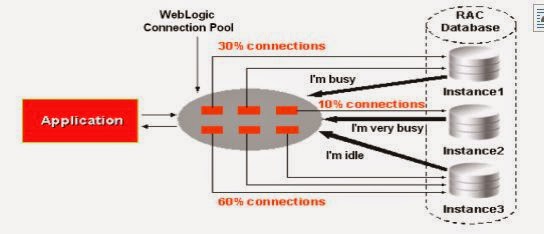GridLink data source
can utilize runtime connection load balancing (RCLB) to allocate connections to
the RAC instances. This can simplify the configuration of data source and
increases the performance.
WebLogic Server and
Oracle RAC clusters are normally used together. Oracle RAC (real application
clusters) is a module that helps the users on various machines to access a
single database efficiently.
A GridLink data source
can be used to connect the WebLogic Server and an Oracle database service. The
database may include many Oracle RAC clusters. It also enables the
administrators to manage the workload effectively. As the number of services
increase in the database, you can scale the GridLink data sources.
GridLink data source
can utilize runtime connection load balancing (RCLB) to allocate connections to
the RAC instances. This can simplify the configuration of data source and
increases the performance.
The following figure
illustrates the runtime connection load balancing:
The runtime connection
load balancing helps the WebLogic Server in:
Adjusting the
allocation of the work based on CPU, response time and availability.
Reacting to changes in
the RAC topology.
Managing the pooled
connections and increasing the overall performance.
With ONS (oracle
notification service), a GridLink data source can make use of Fast Connection
Failover and reacts to all Oracle RAC events. So, a GridLink data source is
very useful in:
Detecting breakneck
failures.
Aborting and removing
the worthless connections from the pool.
Executing graceful
shutdown for RAC node outages.
Distributing all the
runtime requests to active RAC instances.

No comments:
Post a Comment